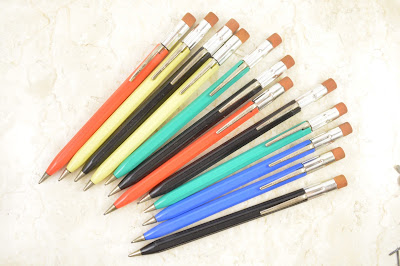This article has been edited and included in The Leadhead's Pencil Blog Volume 4; copies are available print on demand through Amazon here, and I offer an ebook version in pdf format at the Legendary Lead Company here.
If you don't want the book but you enjoy this article, please consider supporting the Blog project here.
This example, like the other transitional members with Sheaffer works, has some unusual design features: note the odd placement of trim rings:
The barrel is stamped with the usual “Gold Bond / Stonite” imprint . . .
. . . but this clearly isn’t the same material. The usual robust plastics used on Gold Bonds don’t crystallize like this:
I bought it knowing about the damage, partly because the pencil is so unusual for a Gold Bond and partly because you never see these with the original paperwork:
Huh. The pencil pictured doesn’t resemble the pencil that came in the box – or any other Gold Bond I’ve seen, for that matter. I am sure based on outward appearances that the mechanism inside this pencil was made by Sheaffer, although I’m not going to try to extract it as fragile as this material is. If Sheaffer had greater involvement in the manufacture of these, supplying whole pencils to National Pen Products, I’d expect to see some similarities between the pencil instruction sheets for a Sheaffer Balance and this – if not identical pictures of the products, at least I’d expect to see identical language.
Come to think of it, though, I haven’t seen an early Sheaffer Balance instruction sheet . . . anyone have one we can compare to this?



















































